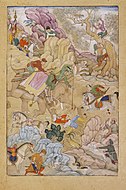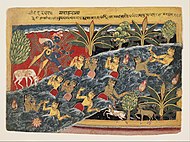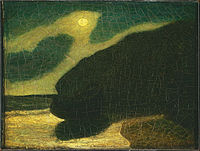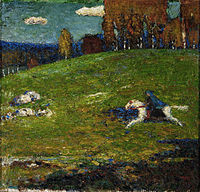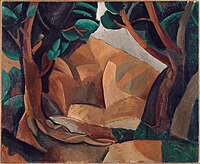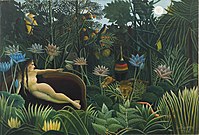Landscape painting
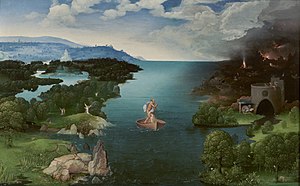
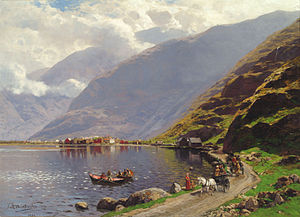

Landscape painting, also known as landscape art, is the depiction of natural scenery such as
Two main traditions spring from
Landscape views in art may be entirely imaginary, or copied from reality with varying degrees of accuracy. If the primary purpose of a picture is to depict an actual, specific place, especially including buildings prominently, it is called a topographical view.[2] Such views, extremely common as prints in the West, are often seen as inferior to fine art landscapes, although the distinction is not always meaningful; similar prejudices existed in Chinese art, where literati painting usually depicted imaginary views, while professional artists painted real views.[3]
The word "landscape" entered the modern English language as landskip (variously spelt), an anglicization of the Dutch landschap, around the start of the 17th century, purely as a term for works of art, with its first use as a word for a painting in 1598.[4] Within a few decades it was used to describe vistas in poetry,[5] and eventually as a term for real views. However the cognate term landscaef or landskipe for a cleared patch of land had existed in Old English, though it is not recorded from Middle English.[6]
History

The earliest forms of art around the world depict little that could really be called landscape, although ground-lines and sometimes indications of mountains, trees or other natural features are included. The earliest "pure landscapes" with no human figures are frescos from Minoan art of around 1500 BCE.[7]
Hunting scenes, especially those set in the enclosed vista of the reed beds of the Nile Delta from Ancient Egypt, can give a strong sense of place, but the emphasis is on individual plant forms and human and animal figures rather than the overall landscape setting. The frescos from the Tomb of Nebamun, now in the British Museum (c. 1350 BC), are a famous example.
For a coherent depiction of a whole landscape, some rough system of perspective, or scaling for distance, is needed, and this seems from literary evidence to have first been developed in

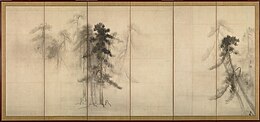
The Chinese
Both the Roman and Chinese traditions typically show grand panoramas of imaginary landscapes, generally backed with a range of spectacular mountains – in China often with waterfalls and in Rome often including sea, lakes or rivers. These were frequently used, as in the example illustrated, to bridge the gap between a foreground scene with figures and a distant panoramic vista, a persistent problem for landscape artists. The Chinese style generally showed only a distant view, or used dead ground or mist to avoid that difficulty.
A major contrast between landscape painting in the West and East Asia has been that while in the West until the 19th century it occupied a low position in the accepted hierarchy of genres, in East Asia the classic Chinese mountain-water ink painting was traditionally the most prestigious form of visual art. Aesthetic theories in both regions gave the highest status to the works seen to require the most imagination from the artist. In the West this was history painting, but in East Asia it was the imaginary landscape, where famous practitioners were, at least in theory, amateur literati, including several emperors of both China and Japan. They were often also poets whose lines and images illustrated each other.[9]
However, in the West, history painting came to require an extensive landscape background where appropriate, so the theory did not entirely work against the development of landscape painting – for several centuries landscapes were regularly promoted to the status of history painting by the addition of small figures to make a narrative scene, typically religious or mythological.
Western tradition
Medieval
In early Western
During the 14th century
Renaissance
Landscape backgrounds for various types of painting became increasingly prominent and skillful during the 15th century. The period around the end of the 15th century saw pure landscape drawings and watercolours from

Landscapes were idealized, mostly reflecting a pastoral ideal drawn from classical poetry which was first fully expressed by Giorgione and the young Titian, and remained associated above all with hilly wooded Italian landscape, which was depicted by artists from Northern Europe who had never visited Italy, just as plain-dwelling literati in China and Japan painted vertiginous mountains. Though often young artists were encouraged to visit Italy to experience Italian light, many Northern European artists could make their living selling Italianate landscapes without ever bothering to make the trip. Indeed, certain styles were so popular that they became formulas that could be copied again and again.[18]
The publication in Antwerp in 1559 and 1561 of two series of a total of 48 prints (the Small Landscapes) after drawings by an anonymous artist referred to as the Master of the Small Landscapes signaled a shift away from the imaginary, distant landscapes with religious content of the world landscape towards close-up renderings at eye-level of identifiable country estates and villages populated with figures engaged in daily activities. By abandoning the panoramic viewpoint of the world landscape and focusing on the humble, rural and even topographical, the Small Landscapes set the stage for Netherlandish landscape painting in the 17th century. After the publication of the Small Landscapes, landscape artists in the Low Countries either continued with the world landscape or followed the new mode presented by the Small Landscapes.[19]
17th and 18th centuries
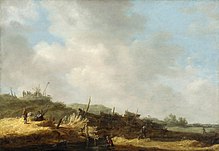

The popularity of exotic landscape scenes can be seen in the success of the painter Frans Post, who spent the rest of his life painting Brazilian landscapes after a trip there in 1636–1644. Other painters who never crossed the Alps could make money selling Rhineland landscapes, and still others for constructing fantasy scenes for a particular commission such as Cornelis de Man's view of Smeerenburg in 1639.
Compositional formulae using elements like the
Dutch Golden Age painting of the 17th century saw the dramatic growth of landscape painting, in which many artists specialized, and the development of extremely subtle realist techniques for depicting light and weather. There are different styles and periods, and sub-genres of marine and animal painting, as well as a distinct style of Italianate landscape. Most Dutch landscapes were relatively small, but landscapes in Flemish Baroque painting, still usually peopled, were often very large, above all in the series of works that Peter Paul Rubens painted for his own houses. Landscape prints were also popular, with those of Rembrandt and the experimental works of Hercules Seghers usually considered the finest.
The Dutch tended to make smaller paintings for smaller houses. Some Dutch landscape specialties named in period inventories include the Batalje, or battle-scene;[22] the Maneschijntje,[23] or moonlight scene; the Bosjes,[24] or woodland scene; the Boederijtje, or farm scene,[25] and the Dorpje or village scene.[26] Though not named at the time as a specific genre, the popularity of Roman ruins inspired many Dutch landscape painters of the period to paint the ruins of their own region, such as monasteries and churches ruined after the Beeldenstorm.[27]
In England, landscapes had initially been mostly backgrounds to portraits, typically suggesting the parks or estates of a landowner, though mostly painted in London by an artist who had never visited his sitter's rolling acres. The English tradition was founded by Anthony van Dyck and other mostly Flemish artists working in England, but in the 18th century the works of Claude Lorrain were keenly collected and influenced not only paintings of landscapes, but the English landscape gardens of Capability Brown and others.
In the 18th century,
In Europe, as
The 18th century was also a great age for the topographical print, depicting more or less accurately a real view in a way that landscape painting rarely did. Initially these were mostly centred on a building, but over the course of the century, with the growth of the

Landscapes in
Leading artists included
19th and 20th centuries
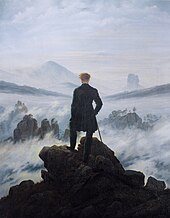
The Romantic movement intensified the existing interest in landscape art, and remote and wild landscapes, which had been one recurring element in earlier landscape art, now became more prominent. The German

The nationalism of the new United Provinces had been a factor in the popularity of Dutch 17th-century landscape painting and in the 19th century, as other nations attempted to develop distinctive national schools of painting, the attempt to express the special nature of the landscape of the homeland became a general tendency. In Russia, as in America, the gigantic size of paintings was itself a nationalist statement. In Poland the main representatives of landscape painting, in the second part of the 19th century, were Maksymilian Gierymski, Józef Chełmoński and Stanisław Masłowski[34][35][36]
In Spain, the main promoter of the genre was the Belgium-born painter Carlos de Haes, one of the most active landscape professors at the Academy of Fine Arts of San Fernando in Madrid since 1857. After studying with the great Flemish landscape masters, he developed his technique to paint outdoors.[37] Back in Spain, Haes took his students with him to paint in the countryside; under his teaching the "painters proliferated and took advantage of the new railway system to explore the furthest corners of the nation's topography."[38][39]

In the United States, the Hudson River School, prominent in the middle to late 19th century, is probably the best-known native development in landscape art. These painters created works of mammoth scale that attempted to capture the epic scope of the landscapes that inspired them. The work of Thomas Cole, the school's generally acknowledged founder, has much in common with the philosophical ideals of European landscape paintings — a kind of secular faith in the spiritual benefits to be gained from the contemplation of natural beauty. Some of the later Hudson River School artists, such as Albert Bierstadt, created less comforting works that placed a greater emphasis (with a great deal of Romantic exaggeration) on the raw, even terrifying power of nature. Frederic Edwin Church, a student of Cole, synthesized the ideas of his contemporaries with those of European Old Masters and the writings of John Ruskin and Alexander von Humboldt to become the foremost American landscape painter of the century.[40] The best examples of Canadian landscape art can be found in the works of the Group of Seven, prominent in the 1920s.[41]
Although certainly less dominant in the period after World War I, many significant artists still painted landscapes in the wide variety of styles exemplified by Edvard Munch, Georgia O'Keeffe, Charles E. Burchfield, Neil Welliver, Alex Katz, Milton Avery, Peter Doig, Andrew Wyeth, David Hockney and Sidney Nolan.
Gallery
-
Joseph Mallord William Turner, The Park at Petworth House, c. 1830
-
Frederic Edwin Church, The Heart of the Andes, 1859. Church was part of the American Hudson River School.
-
Barbizon school
-
The Museum of Modern Art, New York City. Post-Impressionism
-
Claude Monet, Branch of the Seine near Giverny, 1897. The Impressionists often, though by no means always, painted en plein air.
-
Isaac Levitan, Above Eternal Peace, 1894.
-
Henry Bates Joel's 1890's 'Scottish Highlands'; a late-romantic stylized interpretation of nature typical of Victorian painting.
-
"Giving Directions" by George Willis-Pryce.
-
National Museum, Kraków, Sukiennice Museumdiv.
-
National Museum in Warsaw)
East Asian tradition
China


Landscape painting has been called "China's greatest contribution to the art of the world",[44] and owes its special character to the Taoist (Daoist) tradition in Chinese culture.[45] William Watson notes that "It has been said that the role of landscape art in Chinese painting corresponds to that of the nude in the west, as a theme unvarying in itself, but made the vehicle of infinite nuances of vision and feeling".[46]
There are increasingly sophisticated landscape backgrounds to figure subjects showing hunting, farming or animals from the Han dynasty onwards, with surviving examples mostly in stone or clay reliefs from tombs, which are presumed to follow the prevailing styles in painting, no doubt without capturing the full effect of the original paintings.[47] The exact status of the later copies of reputed works by famous painters (many of whom are recorded in literature) before the 10th century is unclear. One example is a famous 8th-century painting from the Imperial collection, titled The Emperor Ming Huang traveling in Shu. This shows the entourage riding through vertiginous mountains of the type typical of later paintings, but is in full colour "producing an overall pattern that is almost Persian", in what was evidently a popular and fashionable court style.[48]
The decisive shift to a monochrome landscape style, almost devoid of figures, is attributed to
The shan shui tradition was never intended to represent actual locations, even when named after them, as in the convention of the Eight Views.[51] A different style, produced by workshops of professional court artists, painted official views of Imperial tours and ceremonies, with the primary emphasis on highly detailed scenes of crowded cities and grand ceremonials from a high viewpoint. These were painted on scrolls of enormous length in bright colour (example below).
Chinese sculpture also achieves the difficult feat of creating effective landscapes in three dimensions. There is a long tradition of the appreciation of "
-
Li Cheng (Chinese: 李成; pinyin: Lǐ Chéng; Wade–Giles: Li Ch'eng; 919–967), Luxuriant Forest among Distant Peaks, detail, Liaoning Provincial Museum, 10th century China
-
Fan Kuan (Chinese: 范寬; pinyin: Fàn Kuān; Wade–Giles: Fan K’uan, c. 960 – c. 1030), Travellers among Mountains and Streams (谿山行旅), ink and slight color on silk, dimensions of 6¾ ft x 2½ ft. 11th century, China.[52] National Palace Museum, Taipei[53]
-
Detail from the hand scroll Pure and Remote View of Streams and Mountains, one of Xia Gui's most important works, 13th century China
-
Li Kan, Bamboos and Rock c. 1300 AD., China
-
Tao Chi, late 17th century China
-
Tang Yin, A Fisher in Autumn, 1523 AD., China
-
Shen Zhou, Poet on a Mountain c. 1500. Painting and poem by Shen Zhou: "White clouds encircle the mountain waist like a sash,/Stone steps mount high into the void where the narrow path leads far./Alone, leaning on my rustic staff I gaze idly into the distance./My longing for the notes of a flute is answered in the murmurings of the gorge."[54]
-
Cai Han and Jin Xiaozhu, Autumn Flowers and White Pheasants, 17th century, China.
-
Shitao, Pine Pavilion Near a Spring, 1675, collection of the Shanghai Museum, 17th century, China.
Japan

The scene from the Biography of the Priest Ippen illustrated below is from a scroll that in full measures 37.8 cm × 802.0 cm, for only one of twelve scrolls illustrating the life of a
Many more pure landscape subjects survive from the 15th century onwards; several key artists are Zen Buddhist clergy, and worked in a monochrome style with greater emphasis on brush strokes in the Chinese manner. Some schools adopted a less refined style, with smaller views giving greater emphasis to the foreground. A type of image that had an enduring appeal for Japanese artists, and came to be called the "Japanese style", is in fact first found in China. This combines one or more large birds, animals or trees in the foreground, typically to one side in a horizontal composition, with a wider landscape beyond, often only covering portions of the background. Later versions of this style often dispensed with a landscape background altogether.
The ukiyo-e style that developed from the 16th century onwards, first in painting and then in coloured woodblock prints that were cheap and widely available, initially concentrated on the human figure, individually and in groups. But from the late 18th century landscape ukiyo-e developed under Hokusai and Hiroshige to become much the best known type of Japanese landscape art.[58]
-
Zen Buddhistmonk, an early figure in the revival of Chinese styles in Japan. Reading in a Bamboo Grove, 1446, Japan
-
Kanō Masanobu, 15th century founder of the Kanō school, which dominated Japanese brush painting until the 19th century, Zhou Maoshu Appreciating Lotuses, hanging scroll[59]
-
The Bridge at Ubi a famous screen composition, found in many 16th or 17th century versions, showing the colourful abstracted style of the professional painters.[60] Yamato-e style of Japanese painting.
-
A scene from the Biography of the Priest Ippen yamato-e scroll, 1299
Persia and India
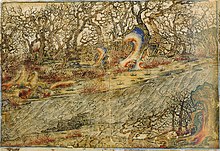
Though there are some landscape elements in earlier art, the landscape tradition of the
Hindu painting had long set scenes amid lush vegetation, as many of the stories depicted demanded. Mughal painting combined this and the Persian style, and in miniatures of royal hunts often depicted wide landscapes. Scenes set during the monsoon rains, with dark clouds and flashes of lightning, are popular. Later, influence from European prints is evident.
-
The Persian heroRustam sleeps, while his horse Rakhsh fends off a lion. Probably an early work by Sultan Mohammed, 1515–20
-
The Feast of Sada, Folio 22v from theShahnama of Shah Tahmasp, Sultan Mohammed, c. 1525
-
Khusraw discovers Shirin bathing in a pool, a favourite scene, here from 1548. The black stream is silver that has oxidized.
-
TheMughal emperor Jahangir's Lion Hunt, c. 1615, in a Persian-style landscape
-
Jahangir hunting with a falcon, in Western-style country.
Techniques

Most early landscapes are clearly imaginary, although from very early on
The distinctive background view across Lake Geneva to the Le Môle peak in The Miraculous Draught of Fishes by Konrad Witz (1444) is often cited as the first Western rural landscape to show a specific scene.[63] The landscape studies by Dürer clearly represent actual scenes, which can be identified in many cases, and were at least partly made on the spot; the drawings by Fra Bartolomeo also seem clearly sketched from nature. Dürer's finished works seem generally to use invented landscapes, although the spectacular bird's-eye view in his engraving Nemesis shows an actual view in the Alps, with additional elements. Several landscapists are known to have made drawings and watercolour sketches from nature, but the evidence for early oil painting being done outside is limited. The Pre-Raphaelite Brotherhood made special efforts in this direction, but it was not until the introduction of ready-mixed oil paints in tubes in the 1870s, followed by the portable "box easel", that painting en plein air became widely practiced.
A curtain of mountains at the back of the landscape is standard in wide Roman views and even more so in Chinese landscapes. Relatively little space is given to the sky in early works in either tradition; the Chinese often used mist or clouds between mountains, and also sometimes show clouds in the sky far earlier than Western artists, who initially mainly use clouds as supports or covers for divine figures or heaven. Both panel paintings and miniatures in manuscripts usually had a patterned or gold "sky" or background above the horizon until about 1400, but frescos by Giotto and other Italian artists had long shown plain blue skies. The single surviving altarpiece from Melchior Broederlam, completed for Champmol in 1399, has a gold sky populated not only by God and angels, but also a flying bird. A coastal scene in the Turin-Milan Hours has a sky overcast with carefully observed clouds. In woodcuts a large blank space can cause the paper to sag during printing, so Dürer and other artists often include clouds or squiggles representing birds to avoid this.
The monochrome Chinese tradition has used ink on silk or paper since its inception, with a great emphasis on the individual brushstroke to define the ts'un or "wrinkles" in mountain-sides, and the other features of the landscape. Western watercolour is a more tonal medium, even with underdrawing visible.
Related -scapes
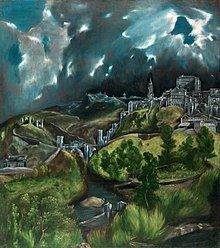


Traditionally, landscape art depicts the surface of the Earth, but there are other sorts of landscapes, such as moonscapes.
- Skyscapes or Cloudscapes are depictions of clouds, weatherforms, and atmospheric conditions.
- Moonscapes show the landscape of a moon.
- Seascapes depict oceans or beaches.
- Riverscapes depict rivers or creeks.
- Cityscapes or townscapes depict cities (urban landscapes).
- Battle scenes are a subdivision of military painting which, when depicting a battle from afar, are set within a landscape, seascape or even a cityscape.
- Hardscapes are paved over areas like streets and sidewalks, large business complexes and housing developments, and industrial areas.
- cloudscapes of Georgia O'Keeffe, the aerial moonscapes of Nancy Graves, or the aerial cityscapes of Yvonne Jacquette.
- surrealist or abstract) artworks which seek to convey the psychoanalytic view of the mind as a three-dimensional space. [For sources on this statement, see the Inscape (visual art)article.]
- Veduteis the Italian term for view, and generally used for the painted landscape, often cityscapes which were a common 18th-century painting thematic.
- Landscape photography
Landscape and modernism
-
American Modernist associated with Tonalism.
-
Expressionistgroup active from 1911 to 1914.
-
Henri Matisse, Landscape at Collioure, 1905, Museum of Modern Art, New York City. Fauvism a Modernist movement in Paris active from 1900 to 1907.
-
André Derain, 1905, Le séchage des voiles (The Drying Sails), oil on canvas, 82 × 101 cm, Pushkin Museum, Moscow. Exhibited at the 1905 Salon d'Automne
-
Jean Metzinger, 1906, Coucher de soleil no. 1 (Landscape), oil on canvas, 72.5 × 100 cm, Rijksmuseum Kröller-Müller, Otterlo, Netherlands
-
Pablo Picasso, 1908, Paysage aux deux figures (Landscape with Two Figures), oil on canvas, 60 x 73 cm, Musée Picasso, Paris
-
The Dream, 1910, Museum of Modern Art, New York
-
Expressionistgroup active after 1905.
-
Le Chemin, Paysage à Meudon, Paysage avec personnage, oil on canvas, 146.4 × 114.4 cm. Stolen by Nazi occupiers from the home of collector Alphonse Kann during World War II
Landscape art movements
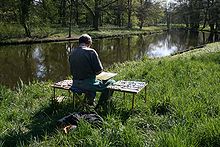
East Asian
- China
- Southern School, 8th–16th centuries, also known as the literati school
- Four Masters of the Yuan Dynasty
- Four Masters of the Ming Dynasty
- Six Masters of the early Qing period, including the Four Wangs
- Japan—often dynastic
- Tosa school 14th or 15th century to 19th
- Kanō school 15th to 19th centuries
- Hasegawa school mid-16th to early 18th century
- Nanga ("Southern painting"), professionals in the Edo period influenced by Chinese literati painting – 17th to 19th centuries
Western
- Pre–19th century
- 19th and 20th century
- American Barbizon school
- American Impressionism
- Amsterdam Impressionism
- Barbizon School
- Düsseldorf school of painting
- Etching revival
- Fauvism
- Group of Seven (Canada)
- Hague School
- Heidelberg School (Australia)
- Hoosier Group
- Hudson River School
- Impressionism
- Luminism (American)
- Luminism (Impressionism)
- Macchiaioli
- Neo-Impressionism
- Norwich School
- Peredvizhniki
- Pont-Aven School
- Post-Impressionism
- Pre-Raphaelite Brotherhood
- The Ten
- Tonalism
- White Mountain art
- Land art
See also
- Claude glass
- Landscape architecture
- Vädersolstavlan
- Visual arts
- Skyscraper
- Category:Landscape paintings
Notes
- ^ "Landscapes, Classical to Modern Curriculum (Education at the Getty)". www.getty.edu. Retrieved 2023-06-08.
- ^ British Library, Topographical collections: an overview Archived 2010-07-21 at the Wayback Machine.
- ^ British Library, Topographical prints and drawings: glossary of terms Archived 2010-07-12 at the Wayback Machine.
- OED"Landscape".
- ^ 1632, John Milton in L'Allegro is the earliest cited by the OED
- ^ The "scaef" coming from the Old English "sceppan" meaning "to shape". OED "Landscape", Ingold, 126; Jackson, 156; Growth & Wilson, 2-3. See the "Etymology" section at Landscape for further detail and references.
- ^ Honour & Fleming, 53. The only very complete example, the Spring Fresco is now in the National Archaeological Museum, Athens, but there are several others with only animal figures, surviving in fragments.
- ^ Honour & Fleming, 150–151
- ^ A major theme throughout both Sickman and Paine. See for example Sickmann pp. 132–133, 182–186, 203–204, 319, 352–356, and Paine pp. 160–168, 235–243.
- ^ Clark, 17–18
- ^ Clark, 23-4; image, another
- ^ The landscape in Western Painting, Minneapolis Institute of the Arts Archived 2009-07-25 at the Wayback Machine retrieved February 20, 2010
- ^ Clark, 31-2
- ^ Clark, 34-37
- ^ Honour & Fleming, 357, see Wood for full coverage
- ISBN 0-8709-9870-6, google books
- ^ See the landscape work of Barent Gael and Jacob van der Ulft, for example, whose Italian-style landscapes were formulaic copies, sometimes from prints.
- ^ Silver, p. 6-7
- ^ Poussin and The Heroic Landscape Archived 2011-09-28 at Wikiwix by Joseph Phelan, retrieved December 17, 2009
- ^ Clark, Chapter 4
- ^ See the work of Willem van de Velde the Younger, Huchtenburg and Pauwels van Hillegaert
- ^ See the work of Aert van der Neer
- Jacques van Artois
- ^ See the work of Adriaen van Ostade
- ^ See the work of Roelant Roghman
- ^ The ruins of Egmond Abbey were popular for a century.
- ^ Slive 17
- ^ Reitlinger, 74-75, 85-87
- ^ Modern Painters, volume three, "Of the novelty of landscape".
- ^ Clark, 15–16.
- ^ Wilton & Lyles, 11-28, 28 quoted
- ^ See Wilton & Lyles, for all these
- National Publishing Institute, 2nd edition - 1976)
- ^ (In Polish):Maciej Masłowski: Malarski żywot Józefa Chełmońskiego (Józef Chełmoński Painter's Life),Warsaw 1965, ed. "PIW" (ed.National Publishing Institute, 2nd edition - 1972); (In Polish):Maciej Masłowski: Józef Chełmoński, Warsaw 1973, ed. „Auriga” - Wydawnictwa Artystyczne i Filmowe (Art and Film Publishers).
- ^ (In Polish): Masłowski M. [ed.]: Stanisław Masłowski – Materiały do życiorysu i twórczości, Wrocław 1957;
- OCLC 38061864.
- )
- )
- ISBN 0-89468-136-2.
- ^ "Landscapes" in Virtual Vault Archived 2016-03-12 at the Wayback Machine, an online exhibition of Canadian historical art at Library and Archives Canada
- ^ Seno, Alexandra A. (2010-11-02). "'River of Wisdom' is Hong Kong's hottest ticket". The Wall Street Journal. Archived from the original on 2017-07-09.
- ^ Sickman, 219-220
- ^ Sickman, 182
- ^ Sickman, 54-55
- ^ Watson, 72
- ^ Sickman, 82-84, and 186
- ^ Sickman, 182–183. p. 182 quoted.
- ^ Sickman, 184–186, and p. 203
- ^ Sickman, 304-305
- ^ Princeton University Art Museum Archived 2011-07-02 at the Wayback Machine Wang Hong (act. ca. 1131-ca. 1161), Eight Views of the Xiao and Xiang Rivers (Xiao-Xiang ba jing)
- ^ Ebrey, Cambridge Illustrated History of China, 162.
- ^ Liu, 50.
- ^ Sickman, 322.
- ^ Paine, 20-21
- ^ Paine, 153–154
- ^ Paine, 107–108
- ^ Paine, 269-272
- ^ Pierce, 177–182
- ^ Watson, 42
- ^ Clark, 26
- ^ "The art of Colorado's landscape". 9 August 2007. Archived from the original on 2015-09-23. Retrieved 2015-09-04. The Denver Post Landscape painting, The art of Colorado's landscape
- ^ Clark, 34
References
- Clark, Sir Kenneth, Landscape into Art, 1949, page refs to Penguin edn of 1961
- Dreikausen, Margret, "Aerial Perception: The Earth as Seen from Aircraft and Spacecraft and Its Influence on Contemporary Art" (Associated University Presses: Cranbury, NJ; London; Mississauga, Ontario: 1985) ISBN 0-87982-040-3
- Growth, Paul Erling Wilson, Chris, Everyday America: Cultural Landscape Studies After J.B. Jackson, 2003, University of California Press, ISBN 0520229614, 9780520229617, google books
- ISBN 0-333-37185-2
- Ingold, Tim, "Being Alive", 2011, Routledge, Abingdon
- Jackson, John B., "The Word Itself", in The Cultural Geography Reader, Eds. Tim Oakes, Patricia Lynn Price, 2008, Routledge, ISBN 1134113161, 9781134113163
- Paine, Robert Treat, in: Paine, R. T. & Soper A, "The Art and Architecture of Japan", Pelican History of Art, 3rd ed 1981, Penguin (now Yale History of Art), ISBN 0-14-056108-0
- Plesu, Andrei, Pittoresque et mélancolie : Une analyse du sentiment de la nature dans la culture européenne, Somogy éditions d'art, 2007
- Reitlinger, Gerald; The Economics of Taste, Vol I: The Rise and Fall of Picture Prices 1760-1960, Barrie and Rockliffe, London, 1961
- Sickman, Laurence, in: Sickman L & Soper A, "The Art and Architecture of China", Pelican History of Art, 3rd ed 1971, Penguin (now Yale History of Art), LOC 70-125675
- Silver, Larry, Peasant Scenes and Landscapes: The Rise of Pictorial Genres in the Antwerp Art Market, University of Pennsylvania Press, 2012
- Slive, Seymour; Hoetink, Hendrik Richard, "Jacob van Ruisdael" (Abbeville Press: New York: 1981 ISBN 978-0-89659-226-1
- Virtual Vault, an online exhibition of Canadian historical art at Library and Archives Canada
- Wilton, Andrew; T J Barringer; Tate Britain (Gallery); Princeton, NJ : Princeton UniversityPress, 2002)
- ISBN 0140218637
- Watson, William, The Great Japan Exhibition: Art of the Edo Period 1600–1868, 1981, Royal Academy of Arts/Weidenfeld & Nicolson
- Andrew Wilton & Anne Lyles, The Great Age of British Watercolours, 1750–1880, 1993, Prestel, ISBN 3791312545
- ISBN 0-948462-46-9
Further reading
- American paradise: the world of the Hudson River school. New York: The Metropolitan Museum of Art. 1987. ISBN 9780870994968.
- Büttner, Nils. "Landscape Painting. A History", New/York/London 2006
- Fong, Wen C.; et al. (2008). Landscapes clear and radiant: the art of Wang Hui (1632-1717). New York: The Metropolitan Museum of Art. ISBN 9781588392916.
- The Landscape in Twentieth-Century American Art, Selections from the ISBN 0-8478-1303-7. Introduction by Robert Rosenblum, and essays by Lowery Stokes Sims and Lisa Messinger. [1]
External links
![]() Media related to Landscape painting at Wikimedia Commons
Media related to Landscape painting at Wikimedia Commons
- History of European landscape painting, from the National Gallery of Art




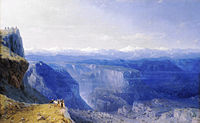



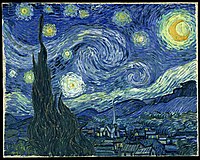

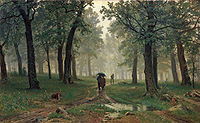


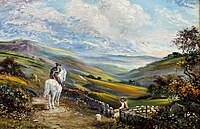
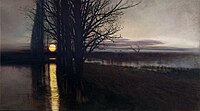
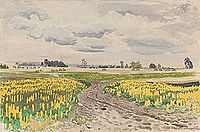

![Fan Kuan (Chinese: 范寬; pinyin: Fàn Kuān; Wade–Giles: Fan K’uan, c. 960 – c. 1030), Travellers among Mountains and Streams (谿山行旅), ink and slight color on silk, dimensions of 6¾ ft x 2½ ft. 11th century, China.[52] National Palace Museum, Taipei[53]](http://upload.wikimedia.org/wikipedia/commons/thumb/c/c2/Fan_Kuan_-_Travelers_Among_Mountains_and_Streams_-_Google_Art_Project.jpg/99px-Fan_Kuan_-_Travelers_Among_Mountains_and_Streams_-_Google_Art_Project.jpg)


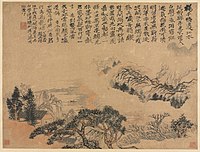

![Shen Zhou, Poet on a Mountain c. 1500. Painting and poem by Shen Zhou: "White clouds encircle the mountain waist like a sash,/Stone steps mount high into the void where the narrow path leads far./Alone, leaning on my rustic staff I gaze idly into the distance./My longing for the notes of a flute is answered in the murmurings of the gorge."[54]](http://upload.wikimedia.org/wikipedia/en/thumb/7/72/Poetonmountain.jpg/200px-Poetonmountain.jpg)



![Kanō Masanobu, 15th century founder of the Kanō school, which dominated Japanese brush painting until the 19th century, Zhou Maoshu Appreciating Lotuses, hanging scroll[59]](http://upload.wikimedia.org/wikipedia/commons/thumb/c/c5/Zhou_Maoshu_Appreciating_Lotuses.jpg/75px-Zhou_Maoshu_Appreciating_Lotuses.jpg)
![The Bridge at Ubi a famous screen composition, found in many 16th or 17th century versions, showing the colourful abstracted style of the professional painters.[60] Yamato-e style of Japanese painting.](http://upload.wikimedia.org/wikipedia/commons/thumb/9/98/Japanischer_Maler_001.jpg/190px-Japanischer_Maler_001.jpg)





